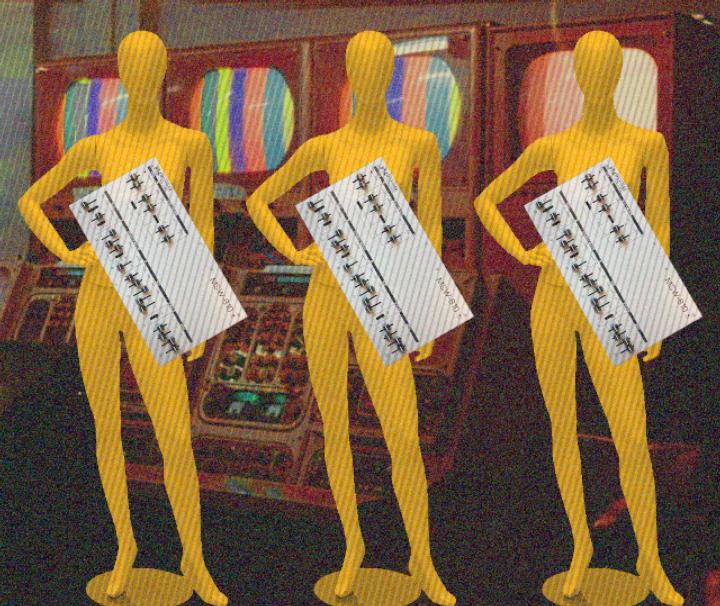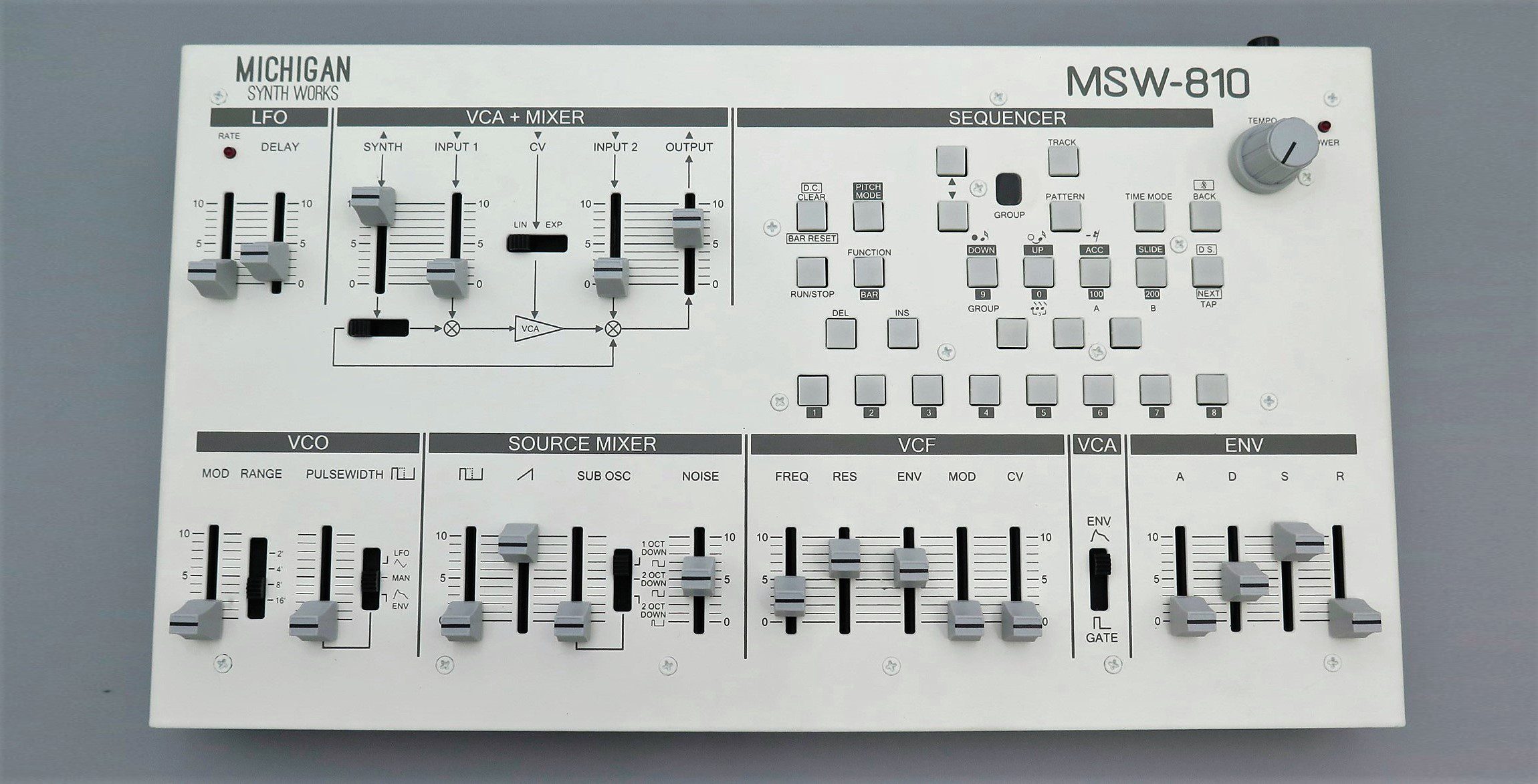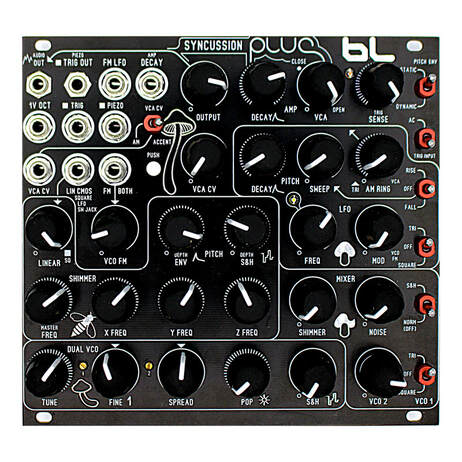Send in the Clones: Michigan Synth Works MSW-810 & SY-1
US Part 1 on cloned synths, will they surpass the originals? 03/12/23

|
Classic synths are coveted for a number of reasons. Whether it be for their warm (or charmingly naive) vintage sound, beautiful aesthetics or unique workflows, the old adage applies; "They don't make 'em like they used to!"...
...Or maybe they do? ln this series of articles, we'll cover attempts to re-make classic synths in the here and now. Will they live up to the original instruments or perhaps even improve on them? Read on, dear viewer...
Roland CMU-810

We're starting off niche! 1983's Roland CMU-800 was a 4-part multi-timbral sound module that connected to an Apple II or IBM PC. 8 CV/GATE outputs could be sequenced alongside some semi-editable voices (think 303/606 territory but more limited) so it would have made for quite a flexible system at the time.
The CMU-810 was an optional expander that added a slider-laden synth to your setup. Controlled via CV/GATE, it was equivalent to a full SH-101/MC-202 synth voice, consisting of a simultaneous saw/pulse oscillator (+ sub), *that* IR3109 filter, an LFO and envelope. What's not to like? Handily, you could also mix in 2 external sources, although these don't go through the VCF. One however does go through the VCA and the other is summed straight to the output.
I very much enjoy the minimalist beige aesthetic of Roland's Compu-music range and Michigan Synth Works must feel the same way, because they've cloned it, using newly-manufactured chips. (The AS3340 and AS3190 for all you IC fanciers!) It even looks the part; a sleek beige box full of sliders. I feel this is a worthwhile endeavour because these (once obscure) pieces are now climbing in price; it's the "vintage Roland" effect.
Check it out below. MSW haven't really fiddled with the design of the 810 (the inputs still don't go through the filter...a missed opportunity?) but they have made a version with MIDI; you may configure note priority, root octave & MIDI channel, a boon for modern workflows.
The regular and non-MIDI versions are priced £320 and £360 respectively. Not bad for a quirky piece with historical interest, though you should probably add another £100 on top for shipping and taxes. Finally, it seems that MSW have built variants with integrated sequencers! These don't appear to be available to purchase (more of a DIY proposition) but still, an intriguing prospect and a great use of space!

https://michigansynthworks.com/
Pearl SY-1 Syncussion

In 1979, the Peal Syncussion appeared on the scene. It offered two independent channels, triggered from a pair of bongo-like drums. Of course, triggering could come a CV/GATE synth or drum machine instead, and this has meant that the machine has found a new lease of life in various electronic genres.
You might be thinking, "so it's a disco tom machine (pew pew pewww) so what?" but the SY-1 is deceptively deep. In addition to the expected TUNE, DECAY & SWEEP controls, there's also an LFO (getting interested yet?) and even a sample & hold circuit. From there, it just gets better, with 6(!) oscillator modes:
A: One oscillator sound, at this position the regular drum synthesizer sweep can be effected.
B. Sound of one oscillator adjusting the other oscillator frequency; produces a metallic sound.
C. Sound of a mix of two oscillator outputs; sound is similar to that of a vibraphone.
D. Sound of mix of two oscillator outputs; produces a low to high sweep and is done by hitting pad softly or hard; there is no connection to SWEEP SPEED and SWEEP RANGE.
E. Sound of one oscillator adjusting the other oscillator frequency with a mix of noise; produces a sound similar to hitting thin metal.
F. Sound of only noise.
With two independent channels and a variety of analog FM and noise timbres (plus a dynamic response to loud and quiet triggers), the Syncussion has found a way into many musician's hearts, and prices have risen in response to this.
The Michigan Synth Works clones come in a few flavours; the original version has two triggers, a mix output, and tuning (via a vintage, long gone pedal). Then there's the expanded I/O model, with adds pitch and (filter or decay) modulation CV inputs, plus two separate outs. Finally, the MIDI version eschews the modulation input for MIDI I/O. MIDI is more than just simple triggering, responding to velocity, pitch, pitch-bend and mod-wheel > filter cutoff! All of these ports are stereo 1/4" TRS by the way, which might not be to everyone's taste; still, they offer great flexibility.
Let's have a listen to the instrument:
There's also a shootout between the clone and the real deal on their website. There you can buy a SY-1 in kit or ready-built form, with prices from £340 - £599 depending on your preferences.
https://michigansynthworks.com/
We should mention that Michigan Synth Works are far from the only company building the Syncussion; sometimes a maker might merely use the design as a starting point for their tinkering experiments. Blue Lantern modules's Syncussion Plus is such a creation, featuring:
- 3 sections: Dual VCO, Shimmer Generator, and White Noise.
- Two trigger circuit inputs: original Syncussion trigger conditioner, and the Blue Lantern 'Piezo' high sensitivity trigger conditioner. Both trigger inputs can be used simultaneously.
- VCO's are triangle based. VCO 1 has a Square wave selected by switch.
- VCO Spread knob separates both vco's pitches from each other to quickly create chord like sound.
- VCO's will respond to 1v/octave input patching.
- There is an FM VCO input for both vco's.
- LFO Section: analog circuit, triangle and square waves selected by switch.
- Has an FM CV input.
- Shimmer Generator: Square wave based XOR ring modded sound generation.
- VCA circuit is OTA LM13700 based. There is a manual open the vca knob and VCA CV input.
- AM Ring is an internal patch from the LFO to the VCA.
- Sample and Hold. This circuit is using a modern IC LF398 for the S&H.
- The sample is from the White Noise, the trigger input is the clock. This creates a random CV signal for every trigger hit.
The RRP is listed as $399, but I've seen them for around £250 on the used market. With a small case and a couple of complementary modules (everybody needs a £70 Doepfer Wasp filter!), you could have a complete, capable and very interesting system!

https://www.bluelanternstore.com/percussion.html#/
Thanks for checking this article out, there's plenty of interesting clones coming out at the moment, from both larger and smaller makers, so let us know in the comments what you'd like to see featured in this ongoing series!
Posted by MagicalSynthAdventure an expert in synthesis technology from last Century and Amiga enthusiast.
More From: MICHIGAN SYNTH WORKS
Even more news...
Want Our Newsletter?
More Stories:
More...
Older Music Machines & the People Who Still Use Them
Revisions that turned synths into brand new machines







